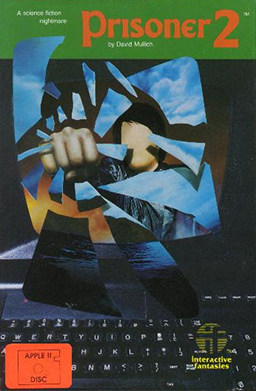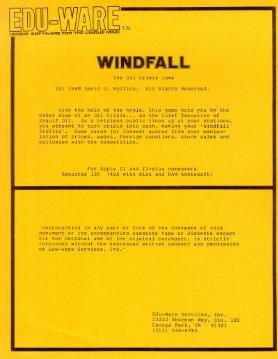Traveller is a science fiction role-playing game first published in 1977 by Game Designers' Workshop. Marc Miller designed Traveller with help from Frank Chadwick, John Harshman, and Loren Wiseman. Editions were published for GURPS, d20, and other role-playing game systems. From its origin and in the currently published systems, the game relied upon six-sided dice for random elements. Traveller has been featured in a few novels and at least two video games.

Wizardry II: The Knight of Diamonds is the second game in the Wizardry series of role-playing video games. It was published in 1982 by Sir-Tech.

Reach for the Stars is a science fiction strategy video game. It is the earliest known commercially published example of the 4X genre. It was written by Roger Keating and Ian Trout of SSG of Australia and published in 1983 for the Commodore 64 and then the Apple II in 1985. Versions for Mac OS, Amiga, Apple IIGS, and DOS were released in 1988.
Edu-Ware Services, Inc. was an educational and entertainment software publisher established in 1979 by Sherwin Steffin and Steven Pederson. It was known for adventure games, role-playing video games, and flight simulators for the Apple II.

GURPS Traveller is a set of table-top role-playing game books by Steve Jackson Games, designed to allow game play in the Third Imperium science-fiction setting from the original Traveller using the GURPS rule system. Loren Wiseman wrote the core book for GURPS Traveller and served as line editor.

Wizardry III: Legacy of Llylgamyn is the third scenario in the Wizardry series of role-playing video games. It was published in 1983 by Sir-Tech.

David Mullich is an American game producer and designer. He created the 1980 adventure game The Prisoner, produced the 1995 adaptation I Have No Mouth, and I Must Scream, and developed Heroes of Might and Magic III and Heroes of Might and Magic IV.

The Prisoner is an adventure game for the Apple II published by Edu-Ware in 1980. It is loosely based on the 1960s television series The Prisoner and incorporates that show's themes about the loss of individuality in a technological, controlling society. The player's role is that of an intelligence agent who has resigned from his job for reasons known only to himself, and who has been abducted to an isolated island community that seems designed to be his own personal prison. The island's authorities will use any means—including coercion, disorientation, deception, and frustration—to learn why their prisoner has resigned, and every character, location, and apparent escape route seem to be part of a grand scheme to trick the player into revealing a code number representing the prisoner's reason for resigning. The game occasionally breaks the fourth wall by acknowledging that a game is being played.

The Prisoner 2 is a video game published in 1982 by Edu-Ware. It is a remake of the 1980 game The Prisoner.
Compu-Read is an educational program originally developed by Sherwin Steffin of Edu-Ware Services in 1979 for the Apple II. It consists of four modules training the user in rapidly increasing comprehension and retention: Character Recognition, High-speed word recognition, Synonyms; Sentence Comprehension. In each, the user the initial difficulty level, and the computer matches the display speed to the user's performance.
Compu-Math was a series of mathematics tutorials developed and published by Edu-Ware Services in the 1980s. Each program in the Compu-Math series begins with a diagnostic Pre-Test, which presents learners with mathematics problems to determine their current skill level in the subject and then recommends the appropriate learning module. Each learning module begins by specifying the instructional objectives for that module and proceeds to teach those specific goals using shaping and cueing methods, and finishes by testing to verify that learners have indeed learned the skills being taught by the module.
Terrorist is a real-time, two-player strategy game developed by Steven Pederson of Edu-Ware Services for the Apple II and published in 1980. One player plays the government authority, while the other plays a terrorist organization in three scenarios: the capture of a building and taking of hostages, air piracy, and nuclear blackmail. Players make their moves at the same time through the use of game paddles. Winner and loser is judged by an elaborate scoring system based upon the government player's societal values and the terrorist player's goals.

Windfall: The Oil Crisis Game is a real-time business simulation game written by David Mullich and published by Edu-Ware in 1980 for the Apple II. Based upon queuing theory and released after the 1979 energy crisis, the game puts the player in the role of chief executive of Engulf Oil, setting gas prices and worker salaries, monitoring gas station lines, scheduling oil tanker arrivals, and negotiating oil prices with OPEC countries in a race against the clock to maximize profits. As with most Edu-Ware games, Windfall has an educational aspect, demonstrating the delicate balance in complex systems.

Network is a real-time, two player business simulation game developed by David Mullich for the Apple II and published by Edu-Ware in 1980.
Compu-Spell is educational software developed by Sherwin Steffin and Steven Pederson of Edu-Ware Services for the Apple II in 1980.

Starfaring was the first science fiction role-playing game (RPG) published, released by Flying Buffalo in August 1976. Although it was the first to market, it didn't attract an audience, and was soon superseded by the much more popular Traveller published the following year.

MegaTraveller 1: The Zhodani Conspiracy is a 1990 space science fiction role-playing video game based on the Traveller series and was produced by Game Designers' Workshop licensee Paragon Software for Amiga, Atari ST, and MS-DOS. The game is set within the Official Traveller Universe and features character creation and other aspects of game mechanics compatible with prior Traveller products. The player controls up to five ex-military adventurers whose objective is to save their civilization, the Imperium, from a conspiracy instigated by the Zhodani, a rival spacefaring race, and aided by the actions of a traitor named Konrad Kiefer. Gameplay features real-time planetary and space exploration, combat, trading, and interaction with various non-player characters in eight solar systems containing twenty-eight visitable planets.

MegaTraveller 2: Quest for the Ancients is a 1991 space science fiction role-playing video game produced by Game Designers' Workshop licensee Paragon Software and distributed by MicroProse and Empire Software. It is the sequel to MegaTraveller 1: The Zhodani Conspiracy. Designed by Marc Miller, an original creator of the Traveller series, the game is set within the Official Traveller Universe and features a character creation system and other elements of game mechanics compatible with previous Traveller products. The game's plot centers on finding a way to stop the flow of slime issuing from an ancient ruin on the planet Rhylanor before it inundates the entire world. Gameplay involves controlling a party of up to five adventurers who engage in real-time exploration, trading, interaction with non-player characters, combat and problem solving on the surface of over a hundred planets and in spaceships journeying between these worlds.

Rendezvous: A Space Shuttle Simulation, is a space simulator published 1982 by Edu-Ware, and developed by Titan Computer Products and NASA scientist Wesley Huntress.

Star Patrol is a science fiction role-playing game published by Gamescience in 1977.














